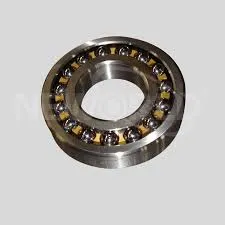
Nov . 09, 2024 11:46 Back to list
Types of Deep Groove Ball Bearings and Their Applications in Various Industries
Understanding Deep Groove Ball Bearing Types
Deep groove ball bearings are among the most commonly used types of bearings in various mechanical applications. Their design, characterized by a deep, uninterrupted raceway, allows for the support of radial and axial loads in both directions. This versatility contributes significantly to their widespread popularity in industries ranging from automotive to aerospace. In this article, we will explore the different types of deep groove ball bearings, their features, advantages, and applications.
Types of Deep Groove Ball Bearings
Deep groove ball bearings can be classified into several categories based on their specific designs and configurations. Here are some of the most common types
1. Single Row Deep Groove Ball Bearings The most basic type, single row deep groove ball bearings consist of a single row of balls and are capable of carrying radial loads as well as axial loads in both directions. They are widely used due to their simplicity and reliability. They are often found in electric motors, gearboxes, and household appliances.
2. Double Row Deep Groove Ball Bearings As the name suggests, double row deep groove ball bearings feature two rows of balls, allowing them to support higher loads compared to their single-row counterparts. This design enhances stability and reduces the overall size of the bearing for certain applications. They are commonly used in industrial machinery and automotive applications.
3. Rubber Sealed Deep Groove Ball Bearings These bearings are equipped with rubber seals that prevent the ingress of dirt, dust, and moisture, providing enhanced protection in harsh environments. Rubber-sealed deep groove ball bearings are often utilized in automotive applications and equipment that are exposed to contaminated or harsh working conditions.
4. Metal Shielded Deep Groove Ball Bearings Similar to rubber sealed bearings, metal shielded deep groove ball bearings have shields on one or both sides to protect against external contaminants. However, they are designed for applications where higher temperatures and greater speeds are present, making them suitable for a more extensive range of industrial settings.
5. Stainless Steel Deep Groove Ball Bearings These bearings are made from stainless steel, providing excellent resistance to corrosion and wear. They are ideal for applications in the food and beverage industry, pharmaceuticals, and other environments where exposure to moisture or corrosive substances is prevalent.
deep groove ball bearing types

6. Hybrid Deep Groove Ball Bearings Hybrid bearings combine ceramic balls with steel rings. The ceramic materials provide several advantageous properties such as reduced weight, lower friction, and superior resistance to wear and corrosion. Hybrid deep groove ball bearings are often used in high-speed applications, such as electric motors and turbines.
Advantages of Deep Groove Ball Bearings
Deep groove ball bearings provide several advantages that make them a preferred choice for many applications
- Versatility They can handle both radial and axial loads, making them suitable for various machinery and equipment. - Cost-Effectiveness Due to their simple design and ease of manufacturing, deep groove ball bearings are typically more affordable than other types of bearings. - Low Friction Their design allows for smooth operation and reduced friction, which contributes to their longevity and reliability. - Low Noise Levels Deep groove ball bearings operate quietly, making them ideal for applications where noise reduction is crucial.
Applications of Deep Groove Ball Bearings
Deep groove ball bearings are used in a diverse array of applications, including
- Automotive They are commonly found in engines, transmissions, and wheel hubs. - Electrical Motors These bearings support the rotors and shafts in various types of motors, helping to maintain their efficiency. - Industrial Equipment Many types of machinery, including conveyor systems, pumps, and compressors, utilize deep groove ball bearings for smooth operation. - Consumer Electronics Appliances such as washing machines, fans, and power tools often rely on deep groove ball bearings for performance.
Conclusion
Deep groove ball bearings play a vital role in modern engineering and mechanical applications. With various types designed to meet specific needs, they offer versatility, durability, and efficiency. Understanding the different types of deep groove ball bearings and their applications can help engineers and manufacturers make informed decisions, ensuring the optimal performance of their machinery and devices. As technology continues to evolve, the role of these bearings in improving efficiency and reliability in various sectors will undoubtedly grow even more significant.
Latest news
-
Premium Deep Groove Ball Bearings | High Speed & Reliability
NewsAug.29,2025
-
Durable Scaffolding Clamps - Secure & Reliable Tube Connectors
NewsAug.28,2025
-
Common Failures in Thrust Ball Bearings and Solutions
NewsAug.22,2025
-
How Tapered Roller Bearings Can Take Shock Loads
NewsAug.22,2025
-
Angular Bearings in High-Precision Spindles
NewsAug.22,2025
-
The Impact of Misalignment on Cylindrical Roller Bearing Performance
NewsAug.22,2025
